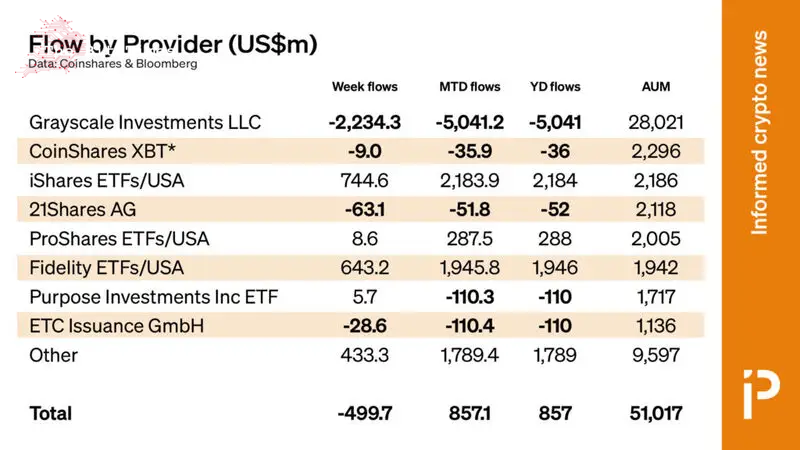More bitcoin ETFs offer yield — but where is it coming from?
A spate of ETF fund managers, including Proshares, Grayscale, Roundhill, and Simplify are announcing interest-bearing spot bitcoin ETFs that promise bitcoin exposure along with generous dividends.
For example, another firm, Purpose Investments, is offering 11.9% yield on its Bitcoin yield ETF in Canada, while other ETF sponsors are aiming for highly variable rates starting at 0.49% and going as high as 33.19% (an annualized figure that is expected to decrease soon).
Grayscale hasn’t announced a yield but jotted 5% as a placeholder in its prospectus.
These new yield strategies are particularly salient given the decline in bitcoin’s price since the SEC approved 11 spot bitcoin ETFs on January 10. Since that date, bitcoin has declined about 8% from approximately $46,000 to near $42,300.
Many bankrupt or troubled entities held GBTC and have been selling after its conversion to an ETF. All of these sales are anomalous stressors on the thinly traded bitcoin options market.
Selling bitcoin covered calls
Most of these ETF managers employ a popular strategy to generate these yields: selling covered calls. In other words, the bitcoin holdings of the ETF cover the call obligation of the sold option.
A call is a bullish bet on the price of an asset. The buyer pays a small premium for the right to purchase a large amount of the asset at a fixed price before a specific date in the future. For example, a bullish Bitcoiner might pay $1,816 for the right to purchase one bitcoin at $100,000 before December 28 on Deribit. The bet only makes sense if bitcoin rallies above $101,816 before that date; otherwise, the contract expires worthless and the buyer has paid $1,816 for nothing.
Therefore, selling a call is a bearish bet on the price of an asset. Specifically, selling a bitcoin-covered call obligates the seller to give their bitcoin to the owner of the call if the price of bitcoin rallies above the call’s strike price before the call’s expiration date. (A covered call where the seller already owns the asset that could be called from them contrasts with an uncovered call where the seller does not already own the asset.)
As a result, selling a call limits one’s upside. If Bitcoin rallies substantially, the seller of a covered call will not benefit from the price beyond the call’s strike price.

Read more: New spot ETF cash inflows less than 0.1% of bitcoin’s market cap
Bitcoin ETF yield in exchange for capped upside
Obviously, selling covered calls is a way to generate interest (also known as income or yield) on Bitcoin ETF holdings. However, if the price of Bitcoin increases quickly — as it often has throughout its history — the call option owners will call the Bitcoin from the fund. This means that the ETF will not benefit from any further price increase.
In other words, yield-bearing spot bitcoin ETFs generate interest in exchange for missing out on quick, large bitcoin rallies.
Nevertheless, for most investors, the appeal of yield is attractive enough to avoid thinking too much about the risks. Few even ask the simple question, “Where does the yield come from?”
Of course, the yield must come from somewhere. But which parties, exactly, provide the yield for these high-yield bitcoin ETF investors?
Every sale is a buy
Unlike many crypto exchanges that misreport up to 95% of transactions, compliant US clearinghouses require every sale to coincide with a buy. Specifically, when someone sells a covered call on a regulated US securities exchange, they usually pledge their collateral to an out-of-the-money call buyer with a strike price above the asset’s current price.
There are variations on this strategy, including call spreads, cash-covered puts, or even using the bitcoin ETF as collateral to sell calls in non-bitcoin options markets. However, selling out-of-the-money bitcoin-covered calls is the safest and most popular method for generating yield on spot bitcoin holdings.
Therefore, most of the yield for covered call ETFs comes from buyers of out-of-the-money calls.
That class of buyer is, by and large, bullish retail investors who want to use options for leverage on their bet that the price of bitcoin will go up quickly. This is a generally less sophisticated market of retail traders who are willing to pay expensive premiums to leverage their bets.
Of course, market-makers who need to hedge positions on other crypto derivatives also buy out-of-the-money calls. For example, market-makers on perpetual futures crypto exchanges like Binance, OKX, KuCoin, or others might temporarily end up selling too many bullish perps. Overly short, they might then buy calls to protect themselves from a quick bull rally.
Not without risks
Options are risky, leveraged financial instruments. Even selling covered calls — widely considered the safest options strategy — can stifle an investment’s potential for far too little yield.
Unlike spot bitcoin ETFs, which the SEC eventually approved after initially objecting, investors in covered call ETFs like Roundhill seek not only price exposure but also income. On Wall Street, there’s no free lunch.
Roundhill Investments’ chief strategy officer said its new bitcoin covered call ETF would generate a monthly income with a monthly upside cap. Only time will tell whether that cap on bitcoin’s price appreciation is worth the small amount of options-derived income.
Since its bitcoin yield ETF launch this month, Roundhill has already made a dividend payout of $1.33 per share and plans to distribute variable dividends monthly.

Read more: Bitcoin drops $60B from market cap as investors shuffle funds into ETFs
Discretion to use ETF holdings as collateral
Most yield-bearing bitcoin ETFs grant generous discretion to the manager for decision-making about which options to trade or how much of the fund to post as collateral. For example, the manager of the Purpose Bitcoin Yield ETF may use up to 50% of the fund to collateralize covered calls or cash-covered puts.
Moreover, the manager has broad authority to choose all of the permissible trades using the fund’s collateral. As explained unambiguously in the fund’s prospectus:
“The decision as to which of the portfolio securities options will be written on, the number of options to be written on such securities, and the terms of such options will be based upon the manager’s assessment of the market and of the best value offered by the option premiums available on the securities held by the fund at the time such options are written.
“Covered call options and cash-covered put options will be written at a strike price that is at-the-money or out-of-the-money as determined by the manager at its discretion.”
Got a tip? Send us an email or ProtonMail. For more informed news, follow us on X, Instagram, Bluesky, and Google News, or subscribe to our YouTube channel.
Comments
Post a Comment